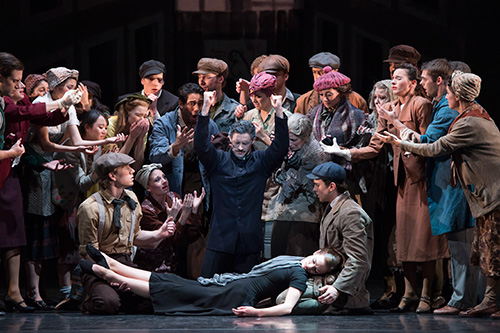18 October 2014 (matinee), Sadler’s Wells Theatre, London
None of the works on Birmingham Royal Ballet’s triple bill program, Shadows of War, focuses on war itself. Rather the focus is on the effects of war on humanity. Of the three works, I have to admit that I was especially interested in Robert Helpmann’s Miracle in the Gorbals, first performed in London in 1944. Archival photos from the National Library of Australia’s various collections relating to Helpmann have always aroused my interest. It was a ballet with a name that I really didn’t understand. Well Birmingham Royal Ballet’s production turned out to be a fascinating restaging of the original, with choreography by Gillian Lynne, ‘after Helpmann’. Lynne appeared in the original production and remained a close friend of Helpmann throughout his life.

There are aspects of this restaging that look dated, which is hardly surprising given that the work is 70 years old. The obvious themes of the evils of prostitution and power of Christianity (or religion), the latter shown via the return to earth of a Christ figure (the Stranger, played originally by Helpmann), seem a somewhat melodramatic way of developing the universal themes of love, betrayal, forgiveness and so forth.
But the strength of the production lies in the strength of the collaborative elements of the original. Edward Burra’s front cloth is a powerful opening image. A huge ship’s prow appears to jut out into the auditorium. It represents the shipyards along the river Clyde in Glasgow where the story is set in slum tenements, the Gorbals. The image is instantly arresting, as is the commissioned score by Arthur Bliss, which reflects so clearly the changing moods and events of the story.
To write down, or explain the narrative is complex but, in fact, the story, in which a mysterious stranger brings a woman back from the dead and reforms a prostitute but is eventually killed by the town’s jealous minister, is instantly understandable as we watch events unfold on stage. And here the collaborative nature of the original comes to the fore again. The libretto was written by Michael Benthall and focuses strongly on developing characters without going into extraneous detail. When Arnold Haskell saw Miracle in 1944 he wrote: ‘With rare skill [Benthall] avoided the pitfalls of novelising his story. Everything that he put down could be made clear in balletic action and was discussed in detail with Helpmann.’ And so it was with the Lynne restaging.
The balletic action is very much in the mode of dance-drama rather than ballet per se. In fact the action was sometimes quite static, often relying on group poses or dramatic stillness. Every dancer gave a powerful performance. Apart from the leading players, Elisha Willis as the Prostitute, César Morales as the Stranger, Iain Mackay as the Minister, and Delia Mathews as the Suicide, standouts for me were Michael O’Hare as the Beggar and three Old Women played by Ruth Brill, Jade Heusen and Marion Tait.

Kenneth MacMillan’s La fin du jour opened the program. This work, which dates to 1979, is danced to Ravel’s Piano Concerto in G Major, and examines the lifestyle of a certain class of people in the inter-war years. It left me a little cold, although I enjoyed the second act, the adagio. Here MacMillan’s skill at using stillness as a choreographic tool was clearly evident as we watched the dancing of two women, each partnered by five men in different combinations with none leaving the stage throughout the scene.
The triple bill closed with David Bintley’s Flowers of the forest. It was a joyous series of dances in the Scottish mode. Bouquets to the gentleman who executed double tours en l’air ending in a full plié in 5th position. Wonderful.
Michelle Potter, 19 October 2014
2 thoughts on “Shadows of War. Birmingham Royal Ballet”